Burnt, recycled, sold: the fate of 2015's temporary pavilions
Bjarke Ingel's Serpentine Gallery Pavilion, which opened last week, will have an afterlife touring Asia and the USA after being bought by Canadian developer Westbank. But what happened to the myriad seasonal architecture marvels erected around the world last year? Dezeen investigates.
Dezeen understands that Ingels' Serpentine Pavilion has been sold to Canadian developer Westbank, which plans to dismantle the modular pavilion and reassemble it various locations abroad.
"The pavilion has a temporary footprint here in the park, and then it's going to travel to Asia and America," the Danish architect told Dezeen in a video interview.
Westbank, one of the main sponsors of this year's pavilion, is also working with Ingel's firm BIG on three residential projects in Canada.
Read on to find out what happened to last year's Serpentine structure and the rest of the 2015 crop of pavilions:
Serpentine Gallery Pavilion by SelgasCano: sold
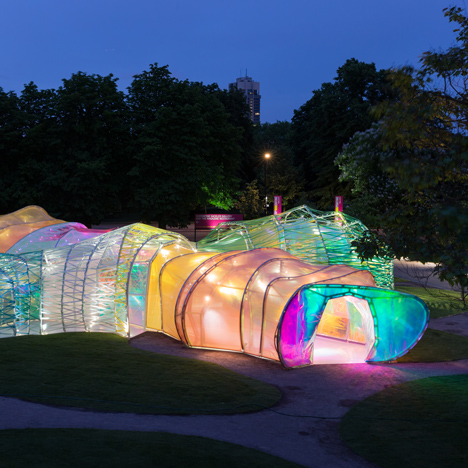
Where was it then? Spanish duo SelgasCano's cruciform ETFE tunnels graced the lawns in front of the Serpentine Gallery last summer as 2015's edition of the annual pavilion commission.
Where is it now? The structure has been bought by Second Home, the shared workplace startup that previously hired SelgasCano to design their London HQ. Second Home plans to rebuild it in downtown Los Angeles this summer as a temporary cultural space for performances and visual art. Find out more about SelgasCano's Serpentine Gallery Pavilion »
Circular Pavilion by Encore Heureux: relocated
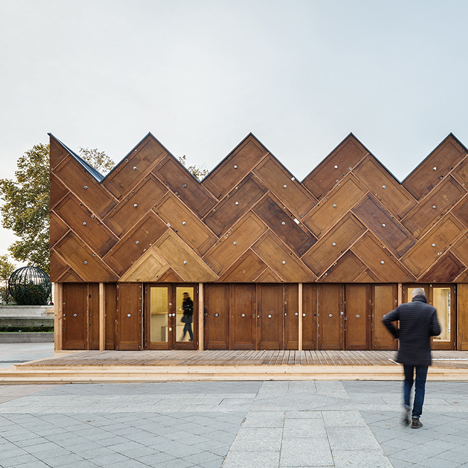
Where was it then? Installed in November 2015 to coincide with the United Nations Climate Change Conference and made almost entirely out of recycled materials, Circular Pavilion sat right outside Paris' city hall. The rectangular structure's counterintuitive name was a reference to the circular nature of reusing and recycling.
Where is it now? The pavilion has been relocated to Paris' 15th Arrondissement to find new life as a bowling association's clubhouse. Find out more about the Circular Pavilion »
Oasis Pavilion for APMAP by OBBA: sold
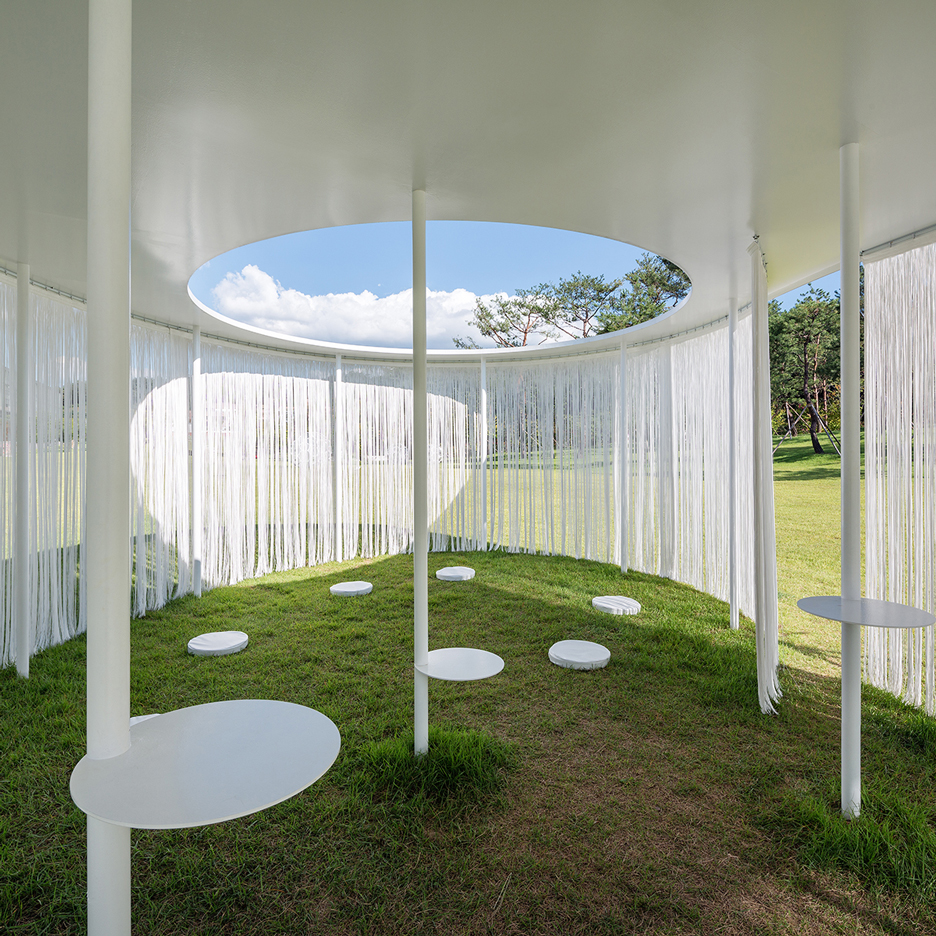
Where was it then? Local studio OBBA created this pavilion for the Amorepacific Museum of Art Project, an annual contemporary art exhibition that travels around the workplaces of the cosmetic brand Amorepacific in South Korea each year. The 2015 edition took place at the Alvaro Siza-designed Amorepacific Research and Design Centre in Seoul.
Where is it now? An unnamed visitor to the Oasis bought it and is having the pavilion rebuilt in the grounds of her own museum. Find out more about the Oasis pavilion »
Kiosque pavilions by Ronan and Erwan Bouroullec: donated
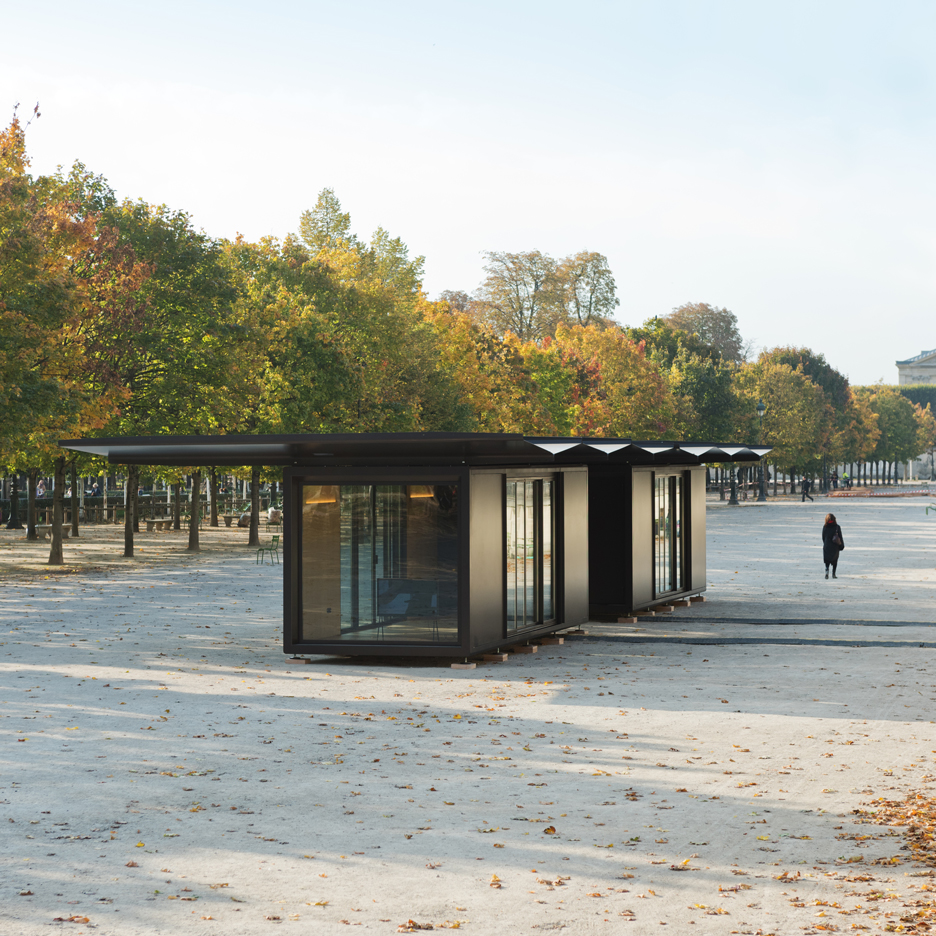
Where was it then? Commissioned by Paris property developer Emerige, this pair of powder-coated steel pavilions designed by the Bouroullecs was constructed in the Jardin des Tuileries – the gardens in front of Paris' Louvre museum – during the city's International Contemporary Art Fair (FIAC) in October.
Where is it now? From the outset these pavilions were set to be donated to the City of Paris after the exhibition. Designed to be assembled in as little as three hours and transported by articulated lorry, they will travel around the city acting as pop-up venues for public events. Find out more about the Kiosque pavilion »
Yure pavilion by Kengo Kuma: relocated
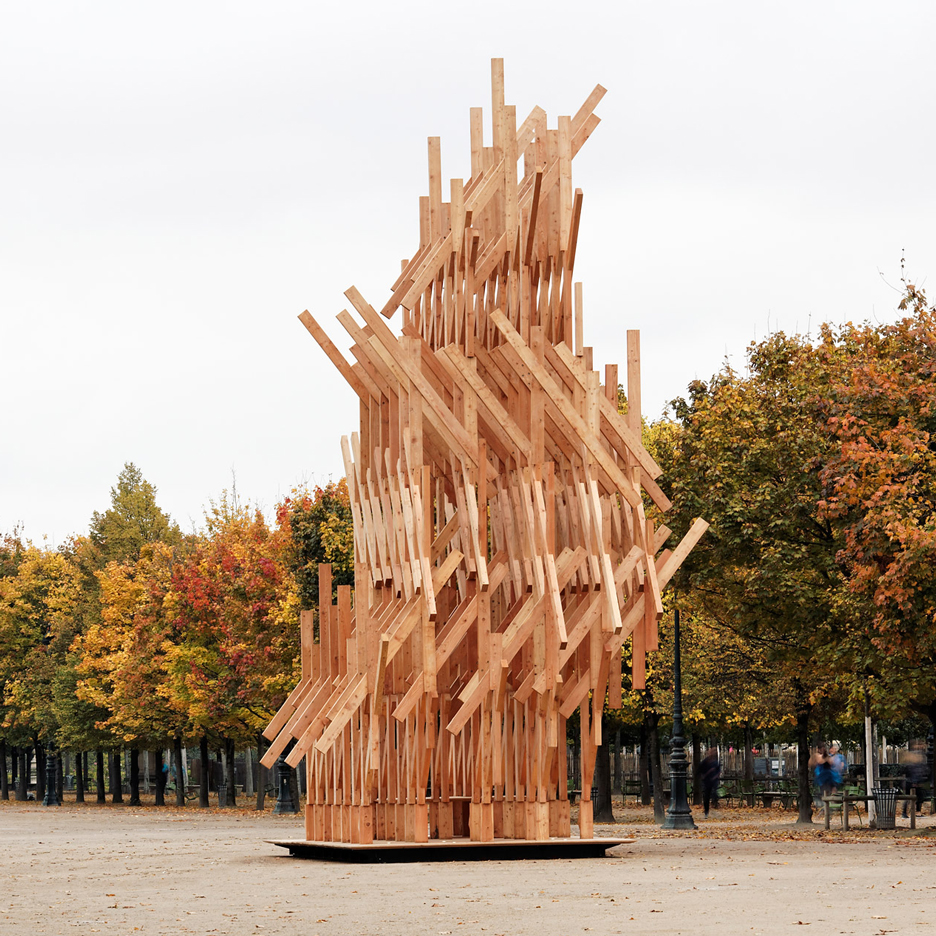
Where was it then? The wooden Yure pavilion by Japanese architect Kengo Kuma for Galerie Philippe Gravier was also built in the Jardin des Tuileries for FIAC.
Where is it now? The Yure Pavilion was removed by the gallery and re-assembled at Château d'Asnières-sur-Seine, also the home of Sou Fujimoto's 2014 Many Small Cubes pavilion for the same gallery.
The gallery is investigating the idea of selling it to sit in front of Kuma's Saint-Denis-Pleyel Station when it is completed. Find out more about the Yure pavilion »
ICD Aggregate Pavilion 2015 by researchers and students from the University of Stuttgart: dismantled
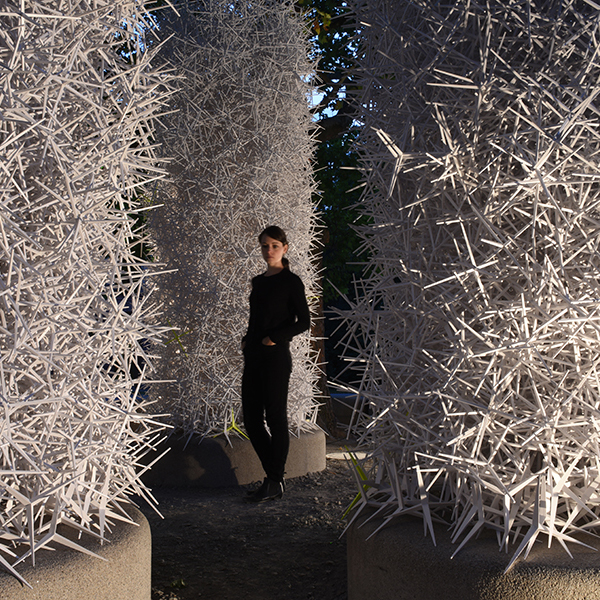
Where was it then? The ICD Aggregate Pavilion was created to be a showcase for granular construction, designed with deconstruction and reconfiguration in mind. Built from 30,000 spiky components using a robot, it was erected over the summer of 2015 on the campus of the Institute for Computational Design.
Where is it now? Built without any binding material, the pavilion was simply taken apart and placed in to storage. The parts will be reused for the Stuttgart team's next structure. Find out more about the ICD Aggregate Pavilion »
Eigen Huis & Interieur pavilion by i29: recycled
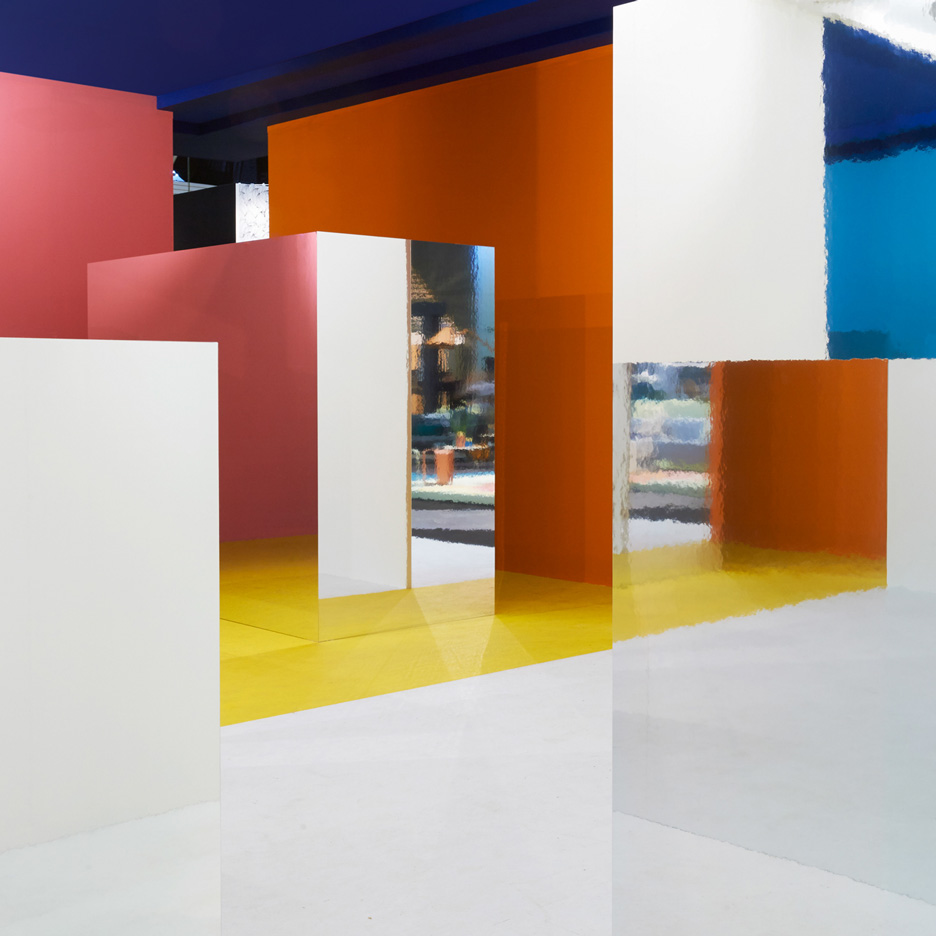
Where was it then? The Eigen Huis pavilion was built as an installation for the Dutch design fair Interieur in October at the RAI Amsterdam exhibition space.
Where is it now? Much of Dutch studio i29's disorientating installation was built by adding coloured and mirrored surfaces to standard fair-stand components, which were disassembled at the end of the event and have since been reused in other installations. Find out more about the Eigen Huis & Interieur pavilion »
MPavilion by Amanda Levete: relocated
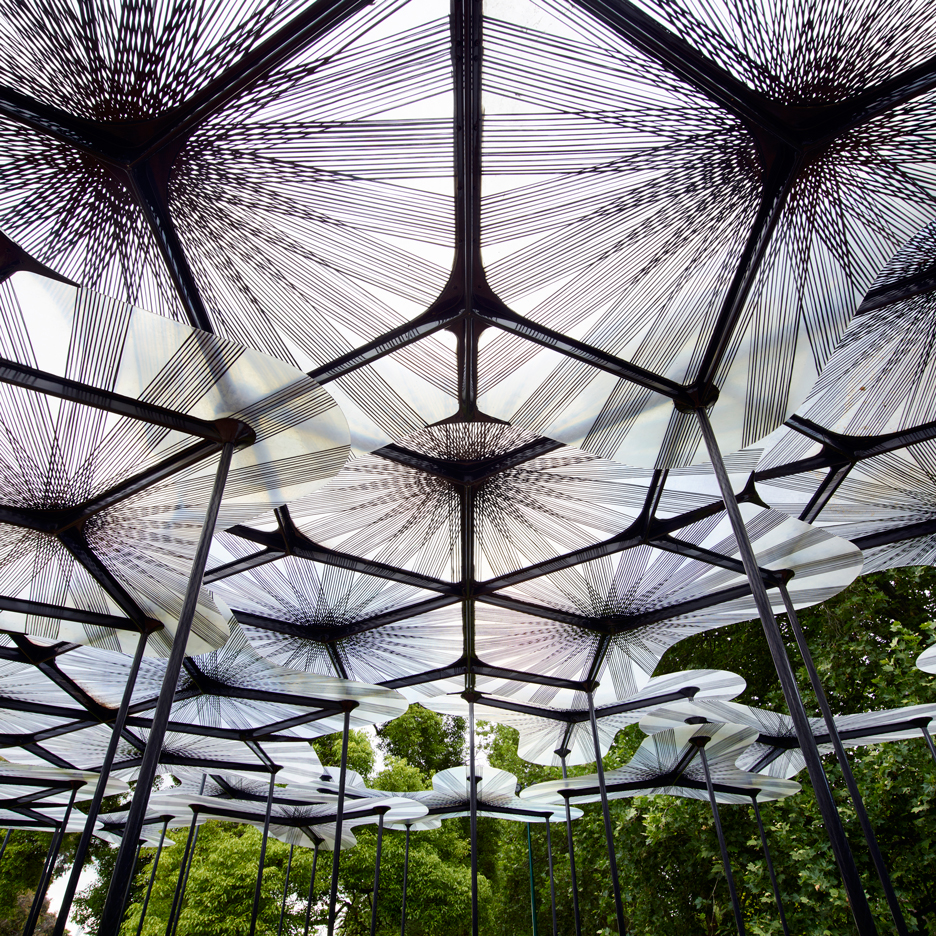
Where was it then? Overlapping fibreglass petals were designed by London architect Amanda Levete to create a transparent roofed structured for Australia's annual MPavilion commission in Melbourne's Queen Victoria Gardens – an official counterpart to the Serpentine Gallery Pavilion in London.
Where is it now? Relocation is part of the designer's brief for the annual MPavilion commission. Levete's pavilion has a new home in a park in the Melbourne docklands, while the previous year's structure by Sean Godsell now sits outside the city's Hellenic Museum. Find our more about Amanda Levete's MPavilion »
Walden Raft by Elise Morin and Florent Albinet: unknown
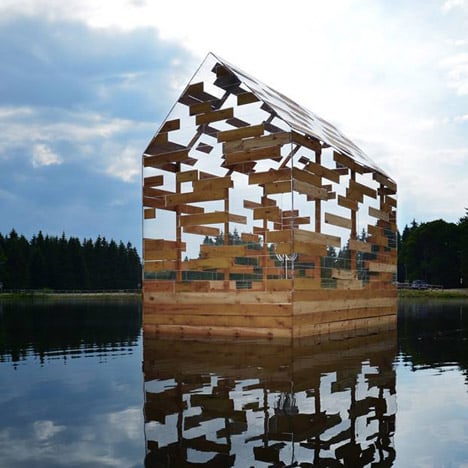
Where was it then? This floating pavilion, based on the solitary cabin of writer Henry David Thoreau, was created for the Horizons arts and nature festival in France last summer.
Where is it now? The pavilion travelled from its original site in central France to the Biela Noc festival of contemporary art in Slovakia in October. Its current location is not known. Find out more about Walden Raft »
Camera Obscura by Mariano Dallago: in storage
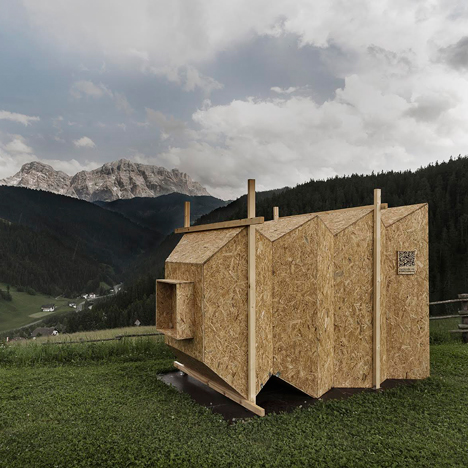
Where was it then? This camera-like wooden pavilion was part of the San Martin Art Culture and History outdoor exhibition in the mountainous Italian province of South Tyrol.
Where is it now? The Camera Obscura was not lucky enough to be the single entry bought by the event's organisers each year. Its creator, photographer Mariano Dallago, has proposed a number of new homes for the pavilion elsewhere in Italy but hasn't yet found a permanent residence for it. Find out more about Camera Obscura »
Around Pavilion by Christiansen and Andersen: recycled
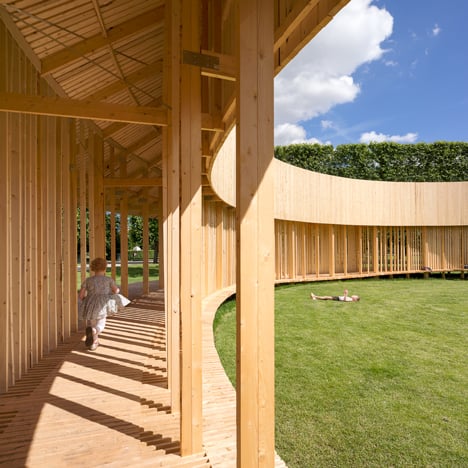
Where was it then? The Around Pavilion was built in the King's Gardens near Denmark's 17th-century royal palace in Copenhagen last summer for another annual programme based on London's Serpentine Gallery Pavilion commission.
Where is it now? The pavilion was dismantled at the end of August and its 16,000 metres of pine battens were donated to the architecture department at Denmark's Royal Academy of Fine Arts for making scale models. Find out more about the Around Pavilion »
Shiver House by NEON: survived
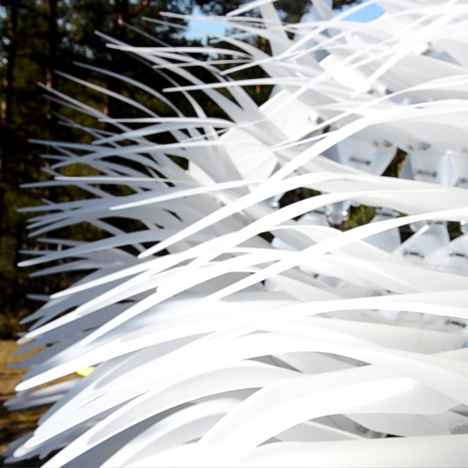
Where was it then? London studio NEON built this pavilion with shingles that "shiver" and adapt in response to changing weather as part of an annual outdoor exhibition focusing on environmental and site-specific art in Korppoo, in the Turku archipelago of southern Finland.
Where is it now? Although originally intended to be a temporary structure, the Shiver House is now permanent and will be part of the 2016 Barfotastigen exhibition. Find out more about Shiver House »
KA300 Pavilion by J Mayer H: dismantled
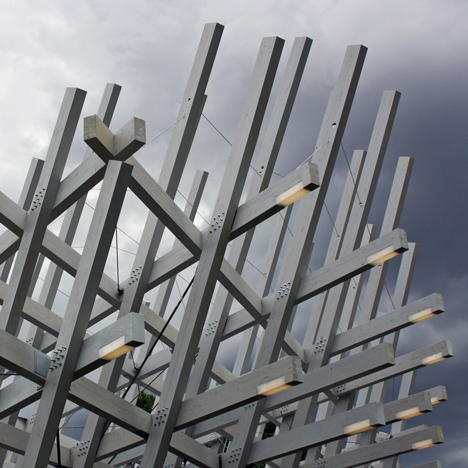
Where was it then? Architect J Mayer H created this latticed timber pavilion for the 300th anniversary of the city of Karlsruhe in Germany last summer. The structure housed a stage and events space, a cafe, an information point and various informal seating areas, as well as a viewing platform on the roof.
Where is it now? The pavilion was dismantled after the festivities and its parts are set to be reused for other projects. Find out more about the KA300 pavilion »
Ekklesia pavilion by Pink Intruder: burnt
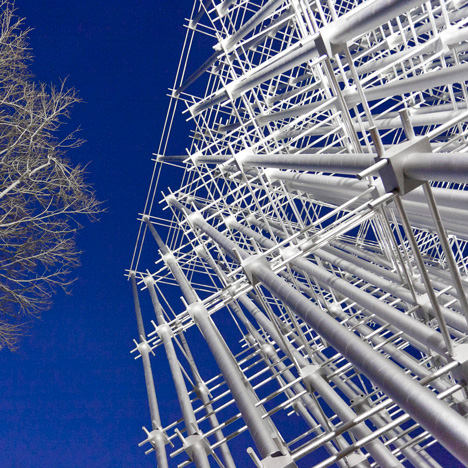
Where was it then? Ekklesia was a cardboard and wooden lattice constructed to encourage debate in a public square in Valencia, Spain, as part of the Fallas festival.
Where is it now? Burnt. All of the structures in the annual festival, which takes place in March, are burned in celebration of the arrival of spring. Find out more about the Ekklesia pavilion »
The Original Dwelling by Atelier van Lieshout: relocated
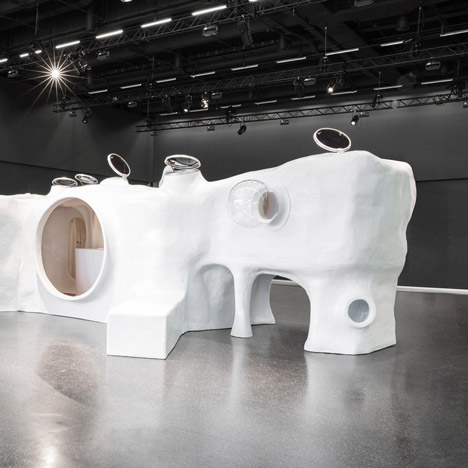
Where was it then? This sculptural pavilion, designed as a house for a fictitious future tribe, was created by Dutch studio Atelier van Lieshout for last year's Design Miami/Basel fair in June.
Where is it now? The structure has found a new home in the Carpenters' Workshop Gallery in Paris and is available to view by appointment. Find out more about The Original Dwelling »
New Horizons Red Pavilion by TAKA, Clancy Moore Architects and Steve Larkin Architects, and Yellow Pavilion by Hall McKnight: in storage
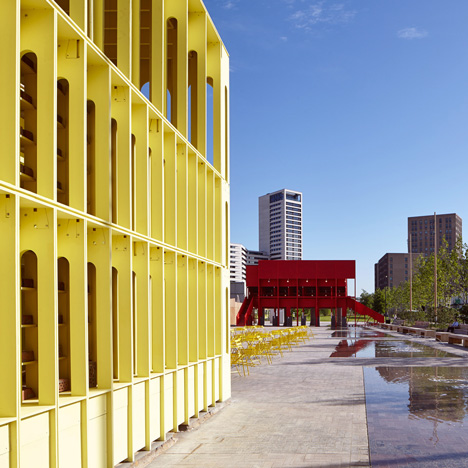
Where was it then? A collaboration between four Irish architects, these two pavilions were constructed for the 2015 London Festival of Architecture last summer and sat in Cubitt Square – part of a huge development zone near London's King's Cross station.
Where is it now? The pavilions were taken down and put in storage after the festival. Proposals for their reuse are currently being explored. Find out more about the Red and Yellow pavilions »
The Temple by Kingston University students: dismantled
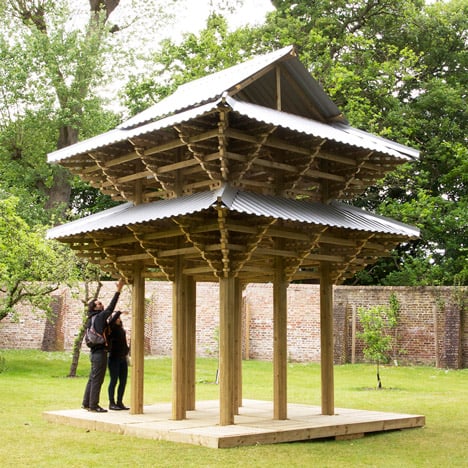
Where was it then? The Temple was built by students at Kingston University in the grounds of the Dorich House Museum as another installation for last summer's London Festival of Architecture.
Where is it now? The Temple is part of an annual student project from the university, which also includes the disassembly of the pavilion at the end of the festival. The timber from last year's structure is due to be reused for the 2016 edition this month. Find out more about The Temple »
Governor's Island pavilions by Bang Studio and Chinchilla Architects: recycled
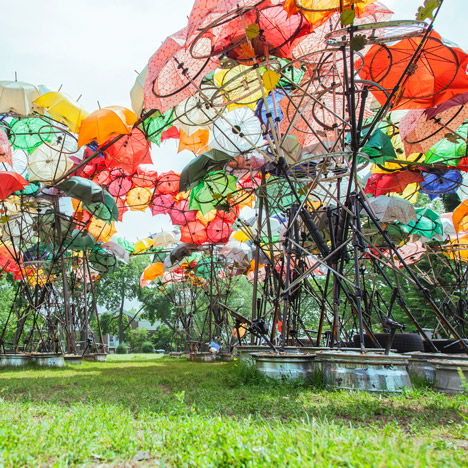
Where was it then? These two structures were built last summer on New York's Governors Island, which hosts an annual pavilion design competition called The City of Dreams.
Where is it now? The competition is focused around the idea of sustainability and reuse. Both of 2015's pavilions have been recycled – BanG studio's Billion Oyster pavilion has been turned into oyster beds off the coast of the island and Chinchilla Architects' Organic Growth Pavilion has been turned in to a number of smaller, permanent shelters and chandeliers around the island. Find out more about the pavilions by Bang Studio and Chinchilla Architects »
The ETH Future Pavilion by ETH Zurich: recycled
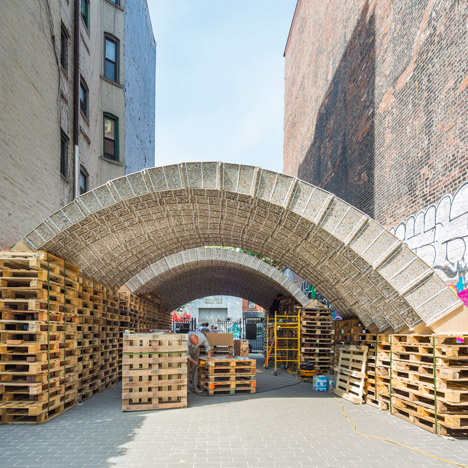
Where was it then? The ETH Zurich Future Pavilion in New York was designed as a showcase for the innovative use of recycled building materials during the city's Ideas City festival last may. It was built on a narrow strip of parkland in the East Village.
Where is it now? The pavilion was completely recycled and the wooden pallets it stood on were returned. ETH researchers suggested that the project could set a precedent for future structures made from rented materials. Find out more about the ETH Future Pavilion »
Glaze pavilion by Cousins & Cousins: sold
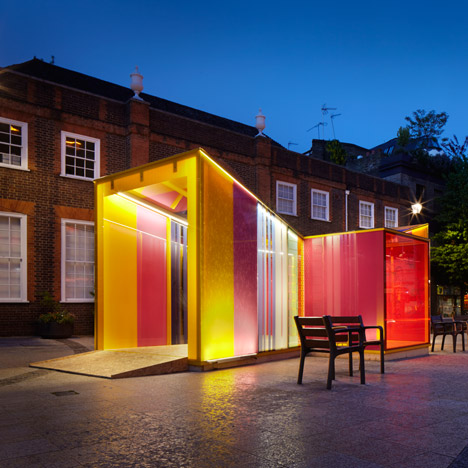
Where was it then? The brightly coloured glass Glaze pavilion was designed for London's 2015 Clerkenwell Design Week as a showcase for glazing company GX Glass.
Where is it now? The structure was bought by South Cambridgeshire District Council for a new site in Histon & Impington, Cambridgeshire. It serves as a shelter, classroom, venue and bar for outdoor events in the centre of Homefield Park. Find out more about the Glaze pavilion »
Pulp Pavilion by Ball-Nogues Studio: recycled
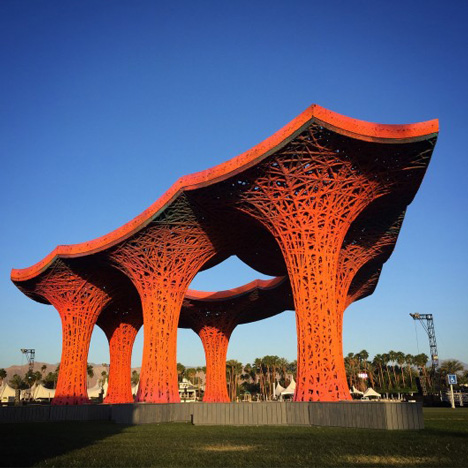
Where was it then? LA studio Ball-Nogues created this pavilion – made from paper pulp sprayed onto tensioned pieces of string – for the Coachella music festival in California, which takes place over two weekends in April.
Where is it now? The five years of research that went into the structure included a series of break tests for its eventual disassembly after the festival. The paper structure was created with no additional chemicals so it could be immediately recycled or composted. Find out more about the Pulp Pavilion »
Brazil Pavilion for Milan Expo by Studio Arthur Casas and Atelier Marko Brajović: sold
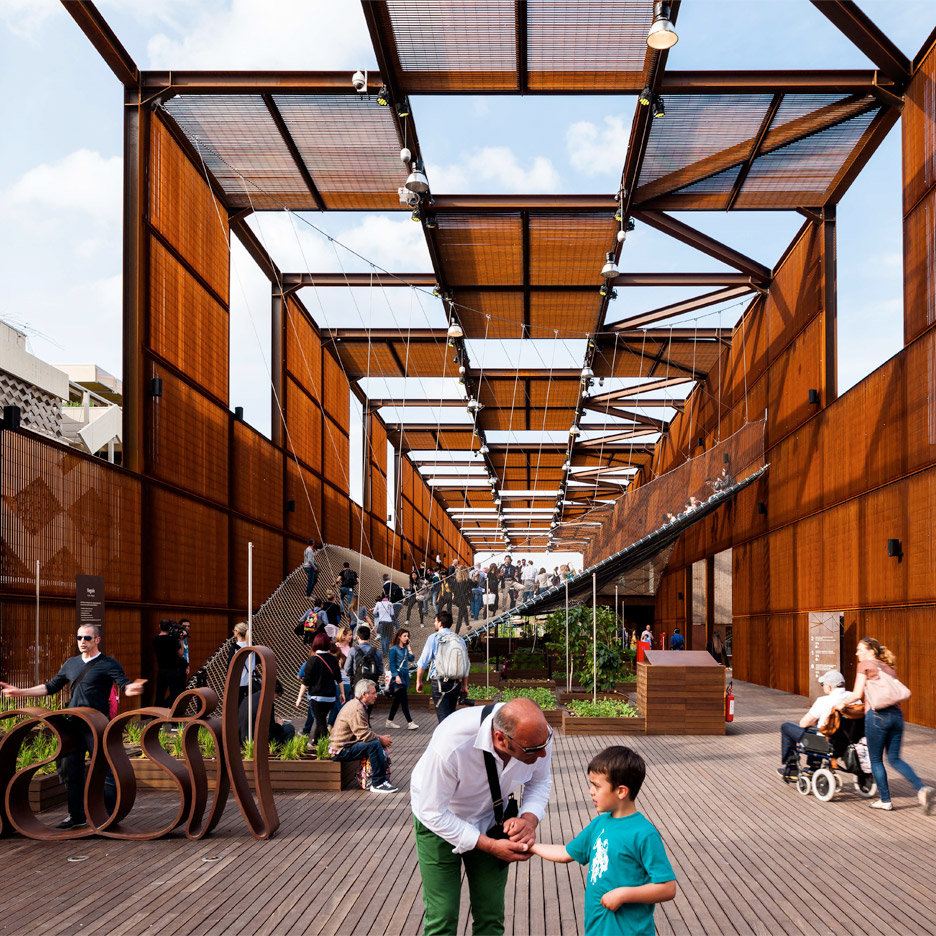
Where was it then? Brazil's pavilion for the Milan Expo site on the outskirts of the Italian city featured a huge climbable rope canopy above a wood-floored garden and was one of the largest structures on the Expo site.
Where is it now? The Brazilian pavilion was auctioned off to an Italian architect, Vito Pellegrino, and the structure is now destined to be installed at Foof – a dog museum in north-western Italy. Find out more about the Brazil pavilion »
France Pavilion for Milan Expo by XTU Architects: in storage
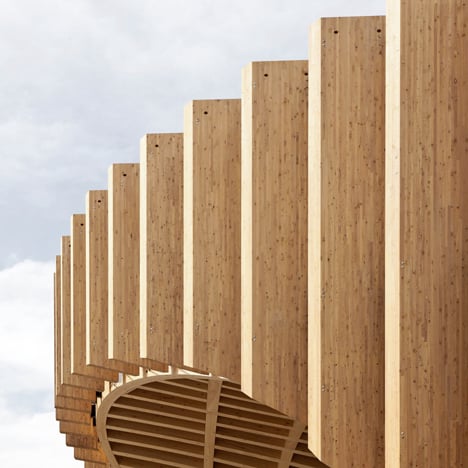
Where was it then? France's Expo pavilion was built using wooden pieces cut by robots, creating a lattice that acted as a trellis for growing fruit and vegetables. It sat alongside other national pavilions on the Expo site.
Where is it now? The architects have proposed a new site for the pavilion near the Eiffel Tower, which is awaiting approval. Other cities in France are also interested in reusing the pavilion as a covered market. Find out more about the France pavilion »
China Pavilion for Milan Expo by Studio Link-Arc and a team from Tsinghua University: modified and relocated
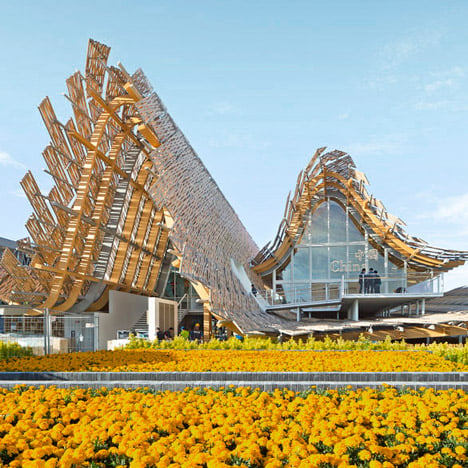
Where was it then? China's innovative glue-laimnated wood, steel and bamboo Expo pavilion won praise for its elaborate construction that merged the profile of the Beijing skyline with a mountain landscape.
Where is it now? The pavilion is being rebuilt in Qingdao near the sea, but it's original architect is unhappy with changes being made to the structure. Much of the wood is being replaced with steel.
"If we view the Pavilion as a significant symbol for culture and an important witness of the Expo history, the construction company should take the responsibility to show people the real China Pavilion," said architect Yichen Lu from Studio Link-Arc. Find out more about the China Pavilion »
The Hive, Britain Pavilion for Milan Expo, by Wolfgang Buttress and BDP: relocated
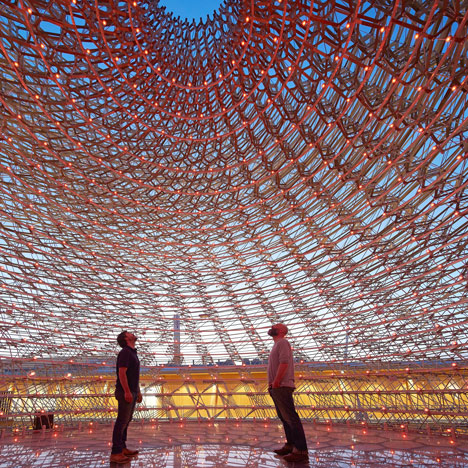
Where was it then? The Hive was named the best national pavilion at the Milan Expo. The 40-tonne metal lattice was surrounded by raised beds of planting and was themed around the lifecycle of the honeybee.
Where is it now? The main structure has been moved to Kew Gardens in London, with a new landscape design. The plants from the original exhibition were donated to the Milano Politecnico. Find out more about The Hive »
UAE Pavilion for Milan Expo by Foster + Partners: relocated
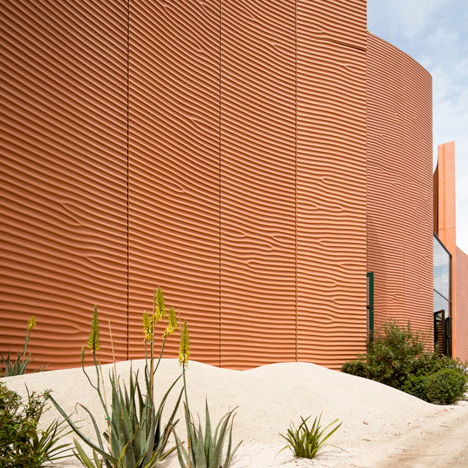
Where was it then? The UAE Pavilion by Foster + Partners sat in the main strip of national pavilions on the Expo site and was designed with panels supported on a steel frame that can be easily demounted for disassembly.
Where is it now? It was packed into shipping crates to be sent to Abu Dhabi, where it will become the Visitor Centre for Masdar, another Foster + Partners project. Find out more about the UAE Pavilion »
Breathe, Austria Pavilion for Milan Expo by Klaus K Loenhart and the Breathe team: recycled
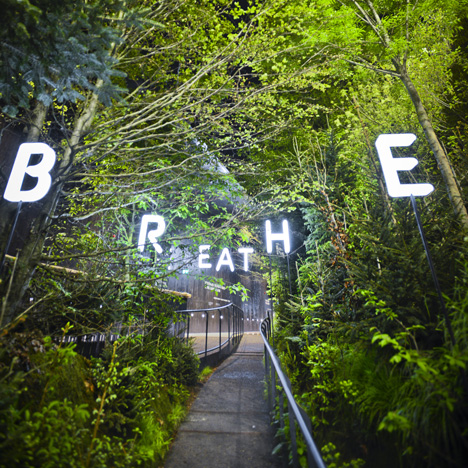
Where was it then? Austria's pavilion for the Milan Expo contained a forest filled with clouds of mist, and contained enough trees to provide a source of oxygen for up to 1,800 people.
Where is it now? Breathe was disassembled and recycled – the wooden shell was reused whilst the greenery, which made up much of the exhibition, was replanted in a reforestation project in Bolzano, South Tyrol. Find out more about Breathe »
Dragon Pavilion for Vanke at Milan Expo by Daniel Libeskind: unknown
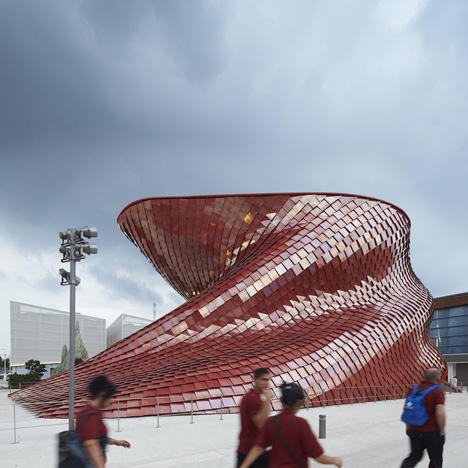
Where was it then? Designed by Daniel Libeskind, this dragon-inspired structure featuring a sinuous body and a scaly red and gold skin was commissioned by China's largest property developer. It was one of the few non-country specific pavilions at the Milan Expo.
Where is it now? Vanke has not revealed its plans for the building. Find out more about the Dragon Pavilion »
Future Food District at Milan Expo by Carlo Ratti: empty
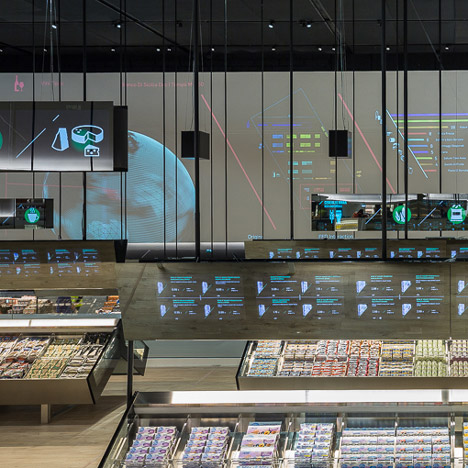
Where was it then? Created by a team led by Italian architect Carlo Ratti, the Future Food District was one of the centrepieces of the Milan Expo and was a direct nod to the theme of the event, which aimed to look at the future of food production.
Where is it now? After the end of the Milan Expo 2015 the Future Food District was emptied of almost all of the elements that made up the installation.
"The Future Food District's fate reflects the general situation of many pavilions of the vast Milan Expo area, which basically remain in place as 'skeletons'," said a representative from Ratti's studio. Find out more about the Future Food District »
Toronto Winter Stations 2015: recycled
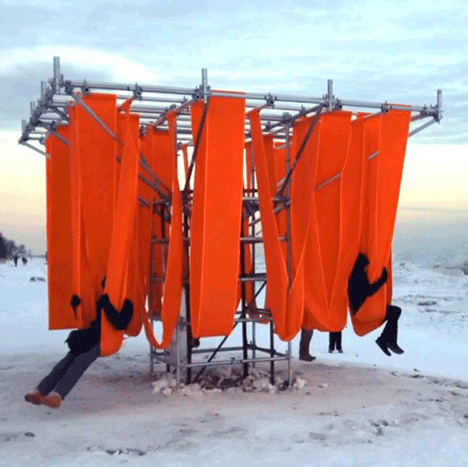
Where was it then? The Toronto Winter Stations are built each winter along the city's frozen waterfront and are each designed by a different team, selected via a competition.
Where is it now? The organisers of the Winter Stations design competition received a number of requests to reuse the five 2015 pavilions but decided that the structures made little sense out of context.
The timber from the pavilions was slowly stripped off for use as firewood at the Wingback installation, providing warmth for visitors to the wintery exhibition. The scaffolding used for the Sling Swing pavilion (pictured) was returned to the rental company, while the fabric swings were repurposed to create hammocks and deck chairs for a summer installation. The 2016 installations faced a similar fate. Find out more about Toronoto's 2015 Winter Stations »
COSMO pavilion for MoMA PS1 by Andrés Jaque and Office for Political Innovation: sold
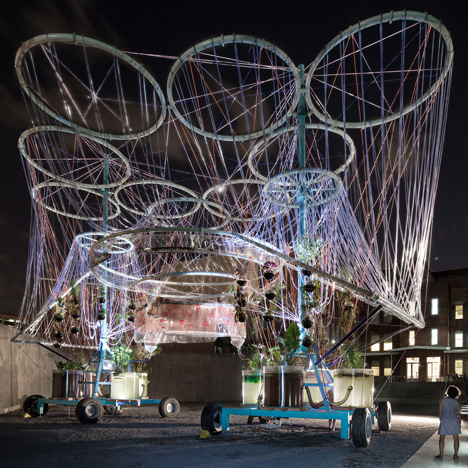
Where was it then? Andrés Jaque's towering network of pipes was designed as a portable water-filtration plant. It was the 2015 installation for the MoMA PS1 Young Architects Program – the US equivalent to the Serpentine Gallery Pavilion – which commissions a different architect to create a structure in the MoMA PS1 gallery's courtyard in Queen's, New York.
Where is it now? The architect's Office for Political Innovation had already seen a number of its temporary designs bought and relocated as permanent installations when it won the MoMA PS1 job.
COSMO has been purchased by a renewable energy tech company that is now deciding on a new location. It will be reinstalled by spring 2017. Find out more about COSMO »